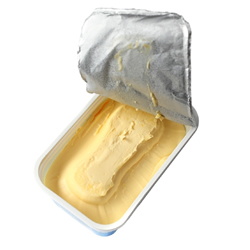Like its model, margarine is about 80% fat, 20% water and solids. It is flavored, colored, and fortified with vitamin A and sometimes D to match butter's nutritional contribution. A single oil or a blend may be used. During World War I, coconut oil was favored; in the thirties, it was cottonseed, and in the fifties, soy. Today, soy and corn oils predominate. The raw oil is pressed from the seeds, purified, hydrogenated, and then fortified and colored, either with a synthetic carotene or with annatto, a pigment extracted from a tropical seed. The water phase is usually reconstituted or skim milk that is cultured with lactic bacteria to produce a stronger flavor, although pure diacetyl, the compound most responsible for the flavor of butter, is also used. Emulsifiers such as lecithin help disperse the water phase evenly throughout the oil, and salt and preservatives are also commonly added. The mixture of oil and water is then heated, blended, and cooled. The softer tub margarines are made with less hydrogenated, more liquid oils than go into stick margarines.
Today, we consume nearly three times as much margarine as we do butter. Margarine overtook butter in popularity in the mid 20th century. Both price and the current concern about cardiovascular disease are responsible for this differential. Margarine, once far cheaper than butter, is still marginally so, and contains none of the cholesterol and less of the saturated fats that have been implicated in heart disease. A fat's hardness at a given temperature is an index of its saturation; the proportion of saturated fats in liquid oil, tub margarine, stick margarine, and butter increases in that order.

